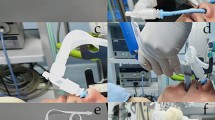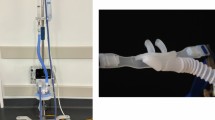Abstract
Purpose
In patients receiving non-intubated video-assisted thoracic surgery (NIVATS), transnasal humidified rapid-insufflation ventilatory exchange (THRIVE) has been applied instead of oxygen mask for better oxygenation. However, the THRIVE effects on intraoperative temperature decrease have not been investigated.
Methods
Pre- and postoperative temperatures, measured by an infrared tympanic ear thermometer, taken before sending patients to the operation room and immediately upon their arrival in the postoperative anesthesia unit, were collected from medical records of patients who received NIVATS either with oxygen mask or THRIVE. Intraoperative temperature decrease, calculated by preoperative temperature minus postoperative temperature, was compared between different groups. Multiple linear regression analysis was performed to determine factors associated with intraoperative temperature decrease.
Results
Records of 256 adult patients with forced-air warming were retrospectively analyzed. 172 patients of them received THRIVE and 84 patients received oxygen mask. Preoperative temperatures were comparable between groups (THRIVE: 36.25 ± 0.46 °C; mask: 36.30 ± 0.39 °C, p = 0.43). Postoperative temperatures were significantly higher in patients using THRIVE than those using oxygen masks (36.05 ± 0.59 vs 35.87 ± 0.62 °C, p = 0.025). Significantly less intraoperative temperature decrease was shown in THRIVE group (THRIVE: 0.20 ± 0.69 °C; mask: 0.43 ± 0.69 °C, p = 0.04). According to the multiple linear regression analysis, significant temperature decrease was associated with the advanced age (βage = 0.01) but not the anesthetic duration. Using THRIVE was correlated with significantly less body temperature decrease (βTRIVE = − 0.24).
Conclusions
THRIVE effectively prevents intraoperative temperature decrease during NIVATS, especially in old patients.



Similar content being viewed by others
References
Min SH, Yoon S, Yoon SH, Bahk JH, Seo JH. Upper versus lower body forced-air warming to prevent hypothermia during thoracoscopic surgery in the lateral decubitus position: a randomised controlled trial. Br J Anaesth. 2018;120(3):555–62.
Bräuer A, English MJ, Lorenz N, Steinmetz N, Perl T, Braun U, Weyland W. Comparison of forced-air warming systems with lower body blankets using a copper manikin of the human body. Acta Anaesthesiol Scand. 2003;47(1):58–64.
Sunaga H, Blasberg JD, Heerdt PM. Anesthesia for nonintubated video-assisted thoracic surgery. Curr Opin Anaesthesiol. 2017;30(1):1–6.
Fitzmaurice BG, Brodsky JB. Airway rupture from double-lumen tubes. J Cardiothorac Vasc Anesth. 1999;13(3):322–9.
Esquinas Rodriguez AM, Scala R, Soroksky A, BaHammam A, de Klerk A, Valipour A, Chiumello D, Martin C, Holland AE. Clinical review: humidifiers during non-invasive ventilation—key topics and practical implications. Crit Care. 2012;16(1):203.
Wang ML, Hung MH, Chen JS, Hsu HH, Cheng YJ. Nasal high-flow oxygen therapy improves arterial oxygenation during one-lung ventilation in non-intubated thoracoscopic surgery. Eur J Cardio Thorac Surg. 2017;53(5):1001–6.
Hernandez G, Roca O, Colinas L. High-flow nasal cannula support therapy: new insights and improving performance. Crit Care. 2017;21(1):62.
Hung MH, Hsu HH, Chen KC, Chan KC, Cheng YJ, Chen JS. Nonintubated thoracoscopic anatomical segmentectomy for lung tumors. Ann Thorac Surg. 2013;96(4):1209–15.
Hung MH, Hsu HH, Chan KC, Chen KC, Yie JC, Cheng YJ, Chen JS. Non-intubated thoracoscopic surgery using internal intercostal nerve block, vagal block and targeted sedation. Eur J Cardiothorac Surg. 2014;46(4):620–5.
Ashraf-Kashani N, Kumar R. High-flow nasal oxygen therapy. BJA Educ. 2017;17(2):57–62.
Jenstrup M, Nielsen J, Fruergard K, Moller AM, Wiberg-Jorgensen F. Total i.v. anaesthesia with propofol-alfentanil or propofol-fentanyl. Br J Anaesth. 1990;64(6):717–22.
Torossian A, Van Gerven E, Geertsen K, Horn B, Van de Velde M, Raeder J. Active perioperative patient warming using a self-warming blanket (BARRIER EasyWarm) is superior to passive thermal insulation: a multinational, multicenter, randomized trial. J Clin Anesth. 2016;34:547–54.
National Institue for Health and Care Excellence. Inadvertent perioperative hypothermia: the management of inadvertent perioperative hypothermia in adults [CG65] [Internet]. London: National Institue for Health and Care Excellence [UK]; 2008. https://www.nice.org.uk/guidance/cg65.
Hasani A, Chapman TH, McCool D, Smith RE, Dilworth JP, Agnew JE. Domiciliary humidification improves lung mucociliary clearance in patients with bronchiectasis. Chronic Respir Dis. 2008;5(2):81–6.
Jagannathan N, Burjek N. Transnasal humidified rapid-insufflation ventilatory exchange (THRIVE) in children: a step forward in apnoeic oxygenation, paradigm-shift in ventilation, or both? Br J Anaesth. 2017;118(2):150–2.
Giesbrecht GG, Ducharme MB, McGuire JP. Comparison of forced-air patient warming systems for perioperative use. Anesthesiology. 1994;80(3):671–9.
Diaz M, Becker DE. Thermoregulation: physiological and clinical considerations during sedation and general anesthesia. Anesth Prog. 2010;57(1):25–33.
Buggy DJ, Crossley AW. Thermoregulation, mild perioperative hypothermia and postanaesthetic shivering. Br J Anaesth. 2000;84(5):615–28.
Kurz A, Plattner O, Sessler DI, Huemer G, Redl G, Lackner F. The threshold for thermoregulatory vasoconstriction during nitrous oxide/isoflurane anesthesia is lower in elderly than in young patients. Anesthesiology. 1993;79(3):465–9.
Belani K, Sessler DI, Sessler AM, Schroeder M, McGuire J, Merrifield B, Washington DE, Moayeri A. Leg heat content continues to decrease during the core temperature plateau in humans anesthetized with isoflurane. Anesthesiology. 1993;78(5):856–63.
Carli F, Gabrielczyk M, Clark MM, Aber VR. An investigation of factors affecting postoperative rewarming of adult patients. Anaesthesia. 1986;41(4):363–9.
Özer AB, Yildiz Altun A, Erhan ÖL, Çatak T, Karatepe Ü, Demirel İ, Çağlar Toprak G. The effect of body mass index on perioperative thermoregulation. Ther Clin Risk Manag. 2016;12:1717–20.
Ranasinghe C, Gamage P, Katulanda P, Andraweera N, Thilakarathne S, Tharanga P. Relationship between Body mass index (BMI) and body fat percentage, estimated by bioelectrical impedance, in a group of Sri Lankan adults: a cross sectional study. BMC Public Health. 2013;13:797.
Kasai T, Hirose M, Matsukawa T, Takamata A, Tanaka Y. The vasoconstriction threshold is increased in obese patients during general anaesthesia. Acta Anaesthesiol Scand. 2003;47(5):588–92.
Steiner AA, Romanovsky AA. Leptin: at the crossroads of energy balance and systemic inflammation. Prog Lipid Res. 2007;46(2):89–107.
Enriori PJ, Sinnayah P, Simonds SE, Garcia Rudaz C, Cowley MA. Leptin action in the dorsomedial hypothalamus increases sympathetic tone to brown adipose tissue in spite of systemic leptin resistance. J Neurosci. 2011;31(34):12189–97.
Kurz A, Sessler DI, Narzt E, Lenhardt R, Lackner F. Morphometric influences on intraoperative core temperature changes. Anesth Analg. 1995;80(3):562–7.
Yi J, Lei Y, Xu S, Si Y, Li S, Xia Z, Shi Y, Gu X, Yu J, Xu G, Gu E, Yu Y, Chen Y, Jia H, Wang Y, Wang X, Chai X, Jin X, Chen J, Xu M, Xiong J, Wang G, Lu K, Yu W, Lei W, Qin Z, Xiang J, Li L, Xiang Z, Pan S, Zhan L, Qiu K, Yao M, Huang Y. Intraoperative hypothermia and its clinical outcomes in patients undergoing general anesthesia: national study in China. PLoS One. 2017;12(6):e0177221.
Yi J, Xiang Z, Deng X, Fan T, Fu R, Geng W, Guo R, He N, Li C, Li L, Li M, Li T, Tian M, Wang G, Wang L, Wang T, Wu A, Wu D, Xue X, Xu M, Yang X, Yang Z, Yuan J, Zhao Q, Zhou G, Zuo M, Pan S, Zhan L, Yao M, Huang Y. Incidence of inadvertent intraoperative hypothermia and its risk factors in patients undergoing general anesthesia in beijing: a prospective regional survey. PLoS One. 2015;10(9):e0136136.
Guo Z, Yin W, Pan H, Zhang X, Xu X, Shao W, Chen H, He J. Video-assisted thoracoscopic surgery segmentectomy by non-intubated or intubated anesthesia: a comparative analysis of short-term outcome. J Thorac Dis. 2016;8(3):359–68.
Amoateng-Adjepong Y, Del Mundo J, Manthous CA. Accuracy of an infrared tympanic thermometer. Chest. 1999;115(4):1002–5.
Ahn HJ, Kim JA, Lee AR, Yang M, Jung HJ, Heo B. The risk of acute kidney injury from fluid restriction and hydroxyethyl starch in thoracic surgery. Anesth Analg. 2016;122(1):186–93.
Patel N, Knapke DM, Smith CE, Napora TE, Pinchak AC, Hagen JF. Simulated clinical evaluation of conventional and newer fluid-warming devices. Anesth Analg. 1996;82(3):517–24.
Funding
This work was supported without funding sources.
Author information
Authors and Affiliations
Corresponding author
Ethics declarations
Ethical approval
The Institutional/Independent Review Board (IRB) of National Taiwan University Hospital waived the need for informed consent. IRB number: 201801005RINB.
Conflict of interest
The authors declare that they have no competing interests.
About this article
Cite this article
Lai, C.J., Yeh, K.C., Wang, M.L. et al. Heated humidified high-flow nasal oxygen prevents intraoperative body temperature decrease in non-intubated thoracoscopy. J Anesth 32, 872–879 (2018). https://doi.org/10.1007/s00540-018-2567-8
Received:
Accepted:
Published:
Issue Date:
DOI: https://doi.org/10.1007/s00540-018-2567-8




